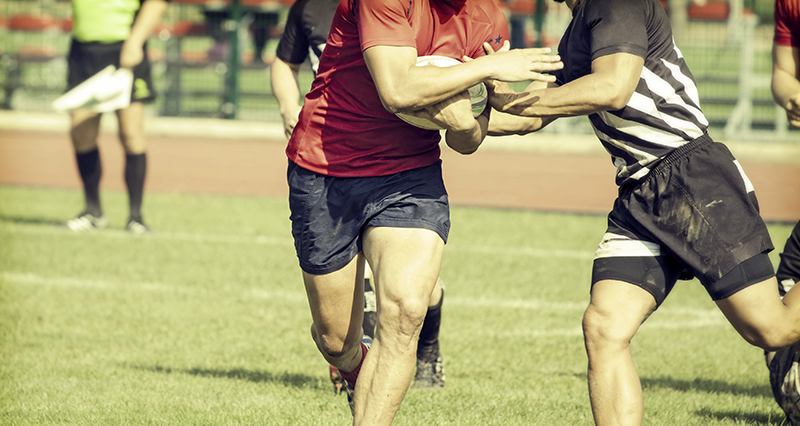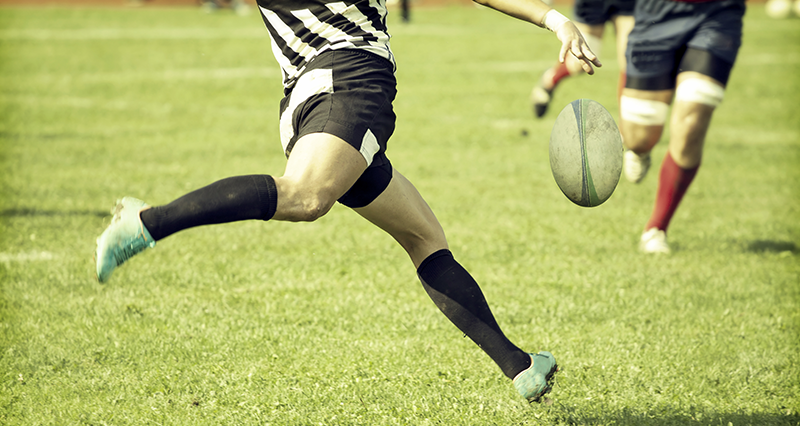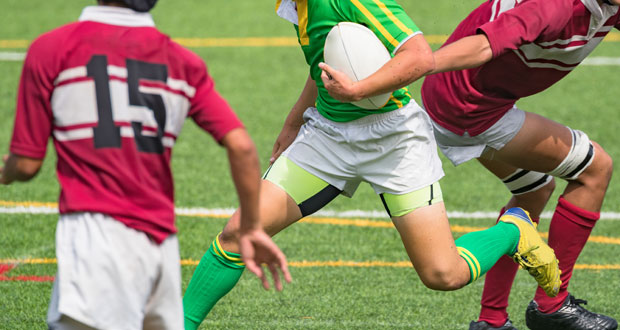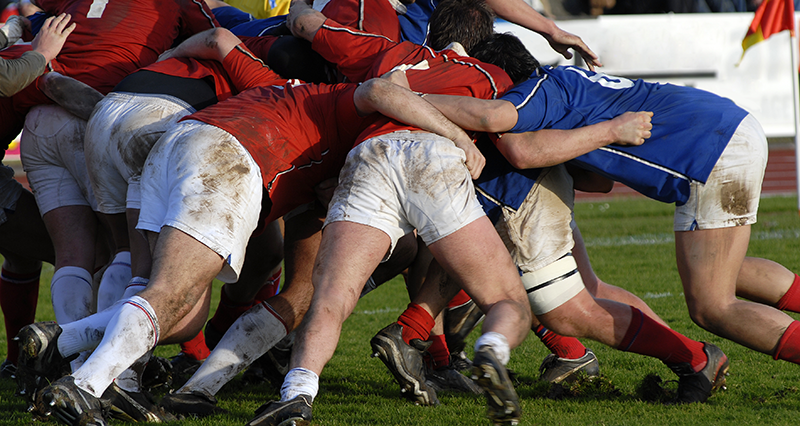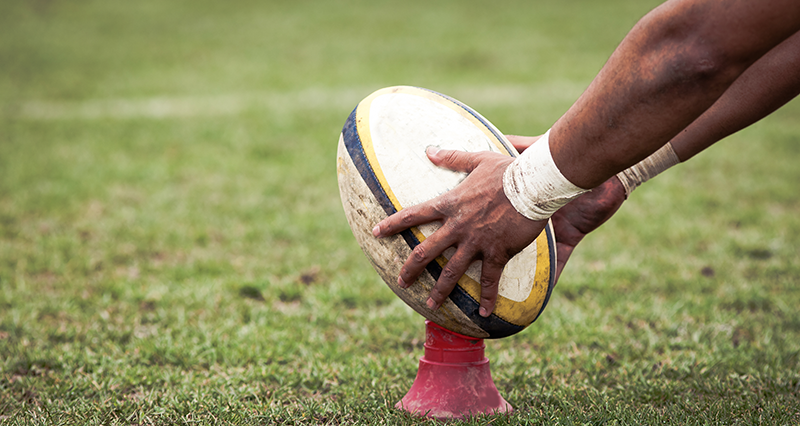Here we demonstrate a number of Rugby passing drills starting with a basic pass and progressing to more advanced drills involving loops and scissor movements.
Basic Pass
This drill explains the very basics of passing. Being able to deliver consistent and accurate passes is an essential skill all rugby players need.
The lateral pass is the most basic of the three but enables players to pass the ball over both short and long distances.
To make a good pass the passers have to be accurate, judge the weight needed, and send the ball at the correct height. Failing to meet just one of these aspects will probably result in the receiver having to slow their run or not catching the ball at all.
Description: Players start with the ball in both hands, using their fingers to control it. They must look at the intended recipient, and then swing their arms in that direction. Use the hand and arm furthest from the receiver to push the ball, just use the other hand as a guide. As players loosen their grip on the ball, they flick their fingers and wrists, so the fingers point towards the target.
Players keep their eyes on the ball. After they have passed the ball, they follow the pass to support their teammate in possession.
How to handle the ball
Being able to handle a rugby ball confidently is an important part of the game. Most skills involve holding the ball, such as running with the ball, passing, catching and even before kicking, the ball must be held.
The ball should be held in both hands whenever possible. This makes it easier to protect the ball from a tackler, or pass the ball to a teammate.
When in possession of the ball fingers should be spread across the seams to help grip the ball better. The palms of the hands should not be used to control the ball, only the fingers should.
When running with the ball the grip often changes. Players like to hold the middle of the ball in their dominant hand and then place it under their arm. This squeezes the ball against the side of the body and the arm, allowing players to run quickly and protect the ball.
However, players need to be able to quickly move the ball back to a two-handed grip so that they can execute a pass when needed.
Switch Pass
Players practice the switch pass or scissors pass with the aid of cones to guide their run. Two lines of players work in a continuous drill.
Explanation: To make a good pass, players have to be accurate, judge the weight needed, and send the ball at the correct height. Failing to meet just one of these aspects will probably result in the receiver having to slow their run or not catching the ball at all.
The switch pass is often used to confuse the opposition and create more space for the ball carrier and the team. It is a great way to change the direction of the attack.
Description: Where possible try to hold the ball in both hands, using the fingers to control the ball. Keep the ball held at chest height, then change the running angle to slide between an opponent and a teammate who is receiving the pass.
The receiver of the pass also plays an important role in the execution of the switch, as they need to make themselves available. They also need to keep an eye on the ball carrier, and the opponent’s positioning. Then as a teammate makes the pass accelerate onto it.
The passer needs to turn so that they have their back to their opponent, hiding the ball, then throw the ball softly up in front of the receiver. The receiver should be able to catch the ball at chest height without breaking their running stride.
After passing the ball the passer should support the receiver.
Pop Pass Drill
Players run as a small group through a narrow channel using a pop pass to the side called by their teammate behind.
This drill purely focuses on the pop pass. Popping is a great skill to have in rugby and is well worth practising.
For the first set of cones, a call should be made from one of the teammates, instructing either a left or right pop pass. However, on the second set of cones, all the pops must be to the left, meaning when the player receives the ball they must step to their right to make space for the next pop.
Loop Pass
The loop pass involves the player running or looping behind the player they pass the ball in order to receive it back the following side.
Explanation: This is the loop pass. It involves the first player running or “looping” around the player he just passed the ball to receive the ball again. The player can loop around any amount of players to receive the ball.
Description: The first player will pass the ball to the second player and then run around the back of the second player to receive the ball again. The first player should proceed to pass the ball down along the line.
Miss Pass Drill
A line of five players practice the miss pass whilst moving forwards. When the ball reaches the end it comes back the other way, again with a miss pass.
This is a Miss Pass drill. It is designed to improve the Miss Pass and the short Pop Pass inside.
Players should perform a miss pass, pop back inside, throw another missed pass and repeat. To make this drill harder and more game-like, do it at a faster pace. Players should hold depth to avoid a forward pass, and to make sure they run onto the ball at pace. The ball should be thrown in front of the player creating a Front Miss Pass.
Miss Pass Behind
This is a move that can be performed by any player on the pitch but is usually performed by a scrum-half or a fly-half. This move is when the ball is thrown behind one player travelling to another.
This move can be performed to confuse the opposition if the move is carried out correctly. It is often known as a “miss pass” as it misses one player and travels to another further along the offensive line.
Description: The player that is going to be missed out (the player that will have the ball passed behind them) must run at speed a shout for the ball to make the opposition think the ball is going to go to him. This player must also overrun so that the ball travels behind him and does not hit him or go in front of him (sometimes it may be useful to duck if the pass is not good. The player who will receive the ball needs to come from deep so that he can run onto the ball quickly. This player will also have more time to perform his run as the ball will travel a long distance to him.
Miss Pass Infront
This is a move that can be performed by any player on the pitch but is usually performed by a scrum-half or a fly-half. This move is when the ball is thrown behind one player travelling to another.
This move can be performed to confuse the opposition if the move is carried out correctly. It is often known as a “miss pass” as it misses one player and travels to another further along the offensive line.
Description: The player that is going to be missed out (the player that will have the ball passed behind them) must run at speed a shout for the ball to make the opposition think the ball is going to go to him. This player must also overrun so that the ball travels behind him and does not hit him or go in front of him (sometimes it may be useful to duck if the pass is not good.) The player who will receive the ball needs to come from deep so that he can run onto the ball quickly. This player will also have more time to perform his run as the ball will travel a long distance to him.
Miss Pass with Loop
Four players pass the ball first with a miss pass, the missed player loops around and receive the ball before continuing the pass down the line.
Explanation: This is both the loop pass and a miss pass all in one. It involves the first player passing the ball to the third missing the second player creating a miss pass. The second player that has just been missed then creates a loop pass with the third man.
Description: Player one throws a miss pass to player 3. Player 2 who has just been missed then loops around player 3 and receives a loop pass. He then passes the ball to player 4 on his outside.
Switch Pass With Dummy
Players pass the ball down the line performing a dummy switch before passing on to the outside man.
Explanation: This is a further progression from the switch. It involves the inside man taking the ball and his outside man performing the same movement he would if a switch pass was being performed. Instead, the ball is not passed to him and is “dummied” and thrown to the outside man.
Description: The scrum half will pass to the first player who will perform a dummy switch. It involves the two players performing the drill to perform an “X” shaped run. The outside man will then come at depth and take the ball running.
Offload Through Tackle 1
Ball-carrying player hits into two tackle bags and then offloads to a teammate running at speed. It encourages the player to keep hold of the ball through contact and look for a pass.
Explanation: This is when the ball carrier brakes through the tackle and offloads the ball after they have broken through. This drill is a 1v2 game situation where the ball carrier breaks through the tackle and offloads to his support player.
Description: The ball carrier should carry the ball in two hands at all times to avoid dropping the ball and to avoid the ball being ripped and taken from his possession. He should hit the tackle low and with the shoulders.
The support players should then come from deep to avoid the forward pass and take the ball at pace.
Offload During Tackle 1
This drill is a progression of a full-contact offload during a tackle. The tackled player aims to stay on their feet whilst offloading to a teammate running behind.
Explanation: This is where the player being tackled offloads the ball before they go to the ground.
Description: The player being tackled must stay on his feet for as long as possible and offload the ball to the support player before they go to the ground.
Passing Offload From Floor
The ball carrier goes into contact, gets tackled and goes to the ground. They then offload the ball to an oncoming player who times their run.
Explanation: This is where the tackled player has the ball on the floor. The tackled player then releases the ball on the floor to the support player.
Description: The tackled player must remember to pass the ball only when they have made contact with the floor. The supporting player must hold depth to avoid a forward pass and to receive the ball at speed and with power.

